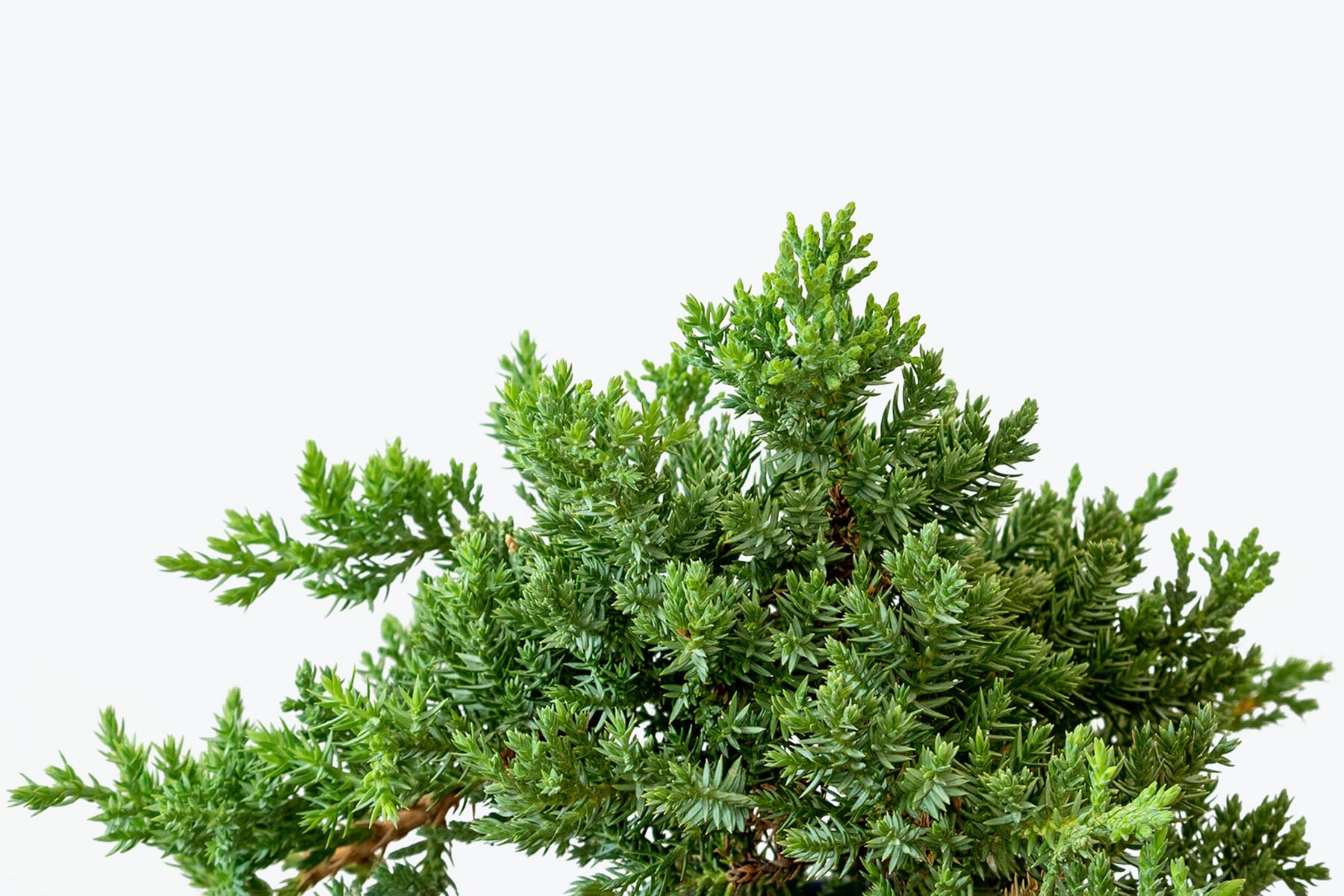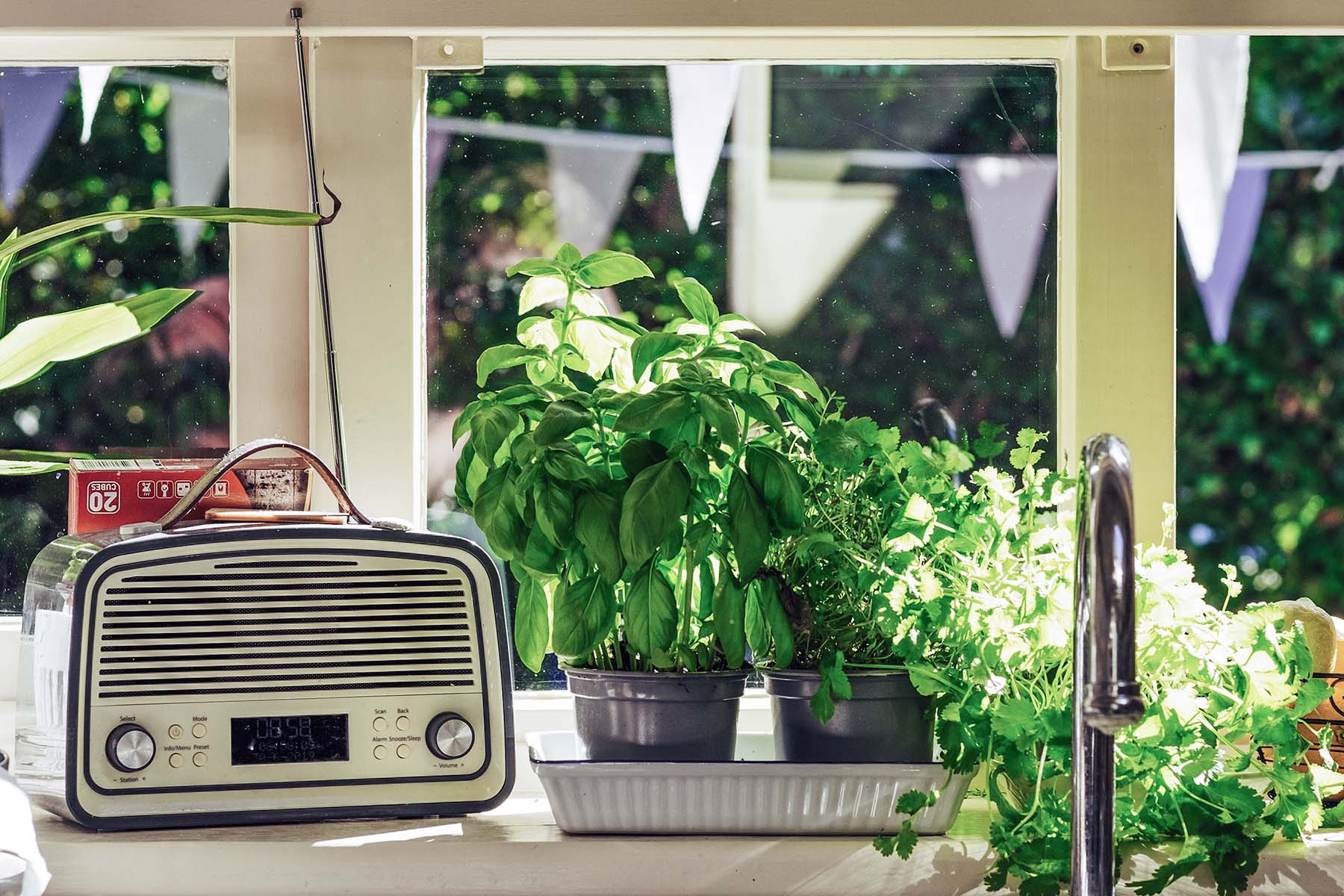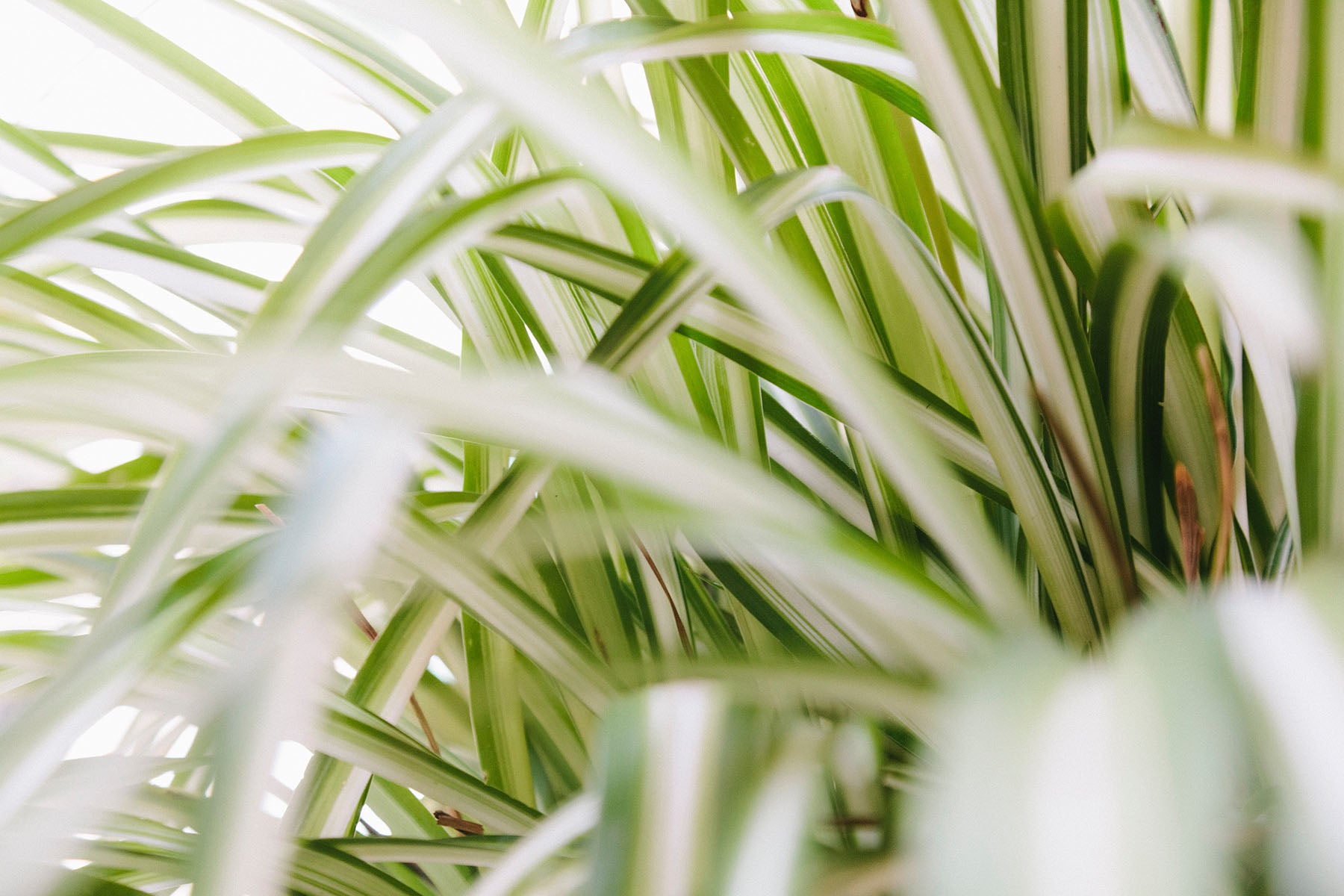
How to Take Care of Your Juniper Bonsai
Known as one of the best bonsai's to learn the art of bonsai through, the Juniper Bonsai is a delightful, compact tree with lush, green, needle-like leaves, their branches often wired into intricate displays. Bonsai is the ancient Japanese art form of growing ornamental miniature or artificially dwarfed trees in shallow containers, using cultivation techniques to mimic the shape and scale of full-sized trees. It's as though you have a tiny version of a huge tree, right on your windowsill! The Juniper Bonsai specifically is a great starter plant on your bonsai journey, since it can thrive on more neglect than other varieties of bonsai.
△ 4" Juniper Bonsai in paper planter
Japanese Garden Juniper Bonsai, or Juniperus Bonsai, is most often the variety that you will see in bonsai form at your local garden centre. They are a part of the Cypress, or, more specifically, the Cupressaceae family, which are coniferous, low-growing shrubs whose hardness of wood makes them extremely desirable for cabinetry and woodworking. The Juniper berries are also often used to infuse gin, creating some delicious flavours.
🌱
It is recommended that they are kept outdoors during the warmer months, bringing them out after the last frost of the spring, and then back in once the temperatures begin to cool again. Transition your plant slowly, giving it time to adjust to the brighter light outdoors. Put your plant in a location that receives very bright light for an hour a day, then increase by an hour each week until the plant has fully adjusted. The same steps should be taken when bringing your plant back inside.
Native to Southern Japan, they thrive in mountain or coastal areas, so they do require the right amount of light and humidity. The reason that they are so popular with beginners is that they can also handle a slightly forgetful owner, as they don't like excessive amounts of water or too much fertilizer. So in some ways, their care is simple, not wanting to be overly pampered, and in others, a little more high maintenance. But, as long as you have the light levels that they need and can provide them with lots of humidity, your plant should thrive.
📋
Let's talk dormancy. Although most houseplants go through a dormant period during the winter months, it is important that a Juniper Bonsai actually receives this period. That being said, they should do so naturally. Keep your plant in a cool room with lots of bright light, as we describe in the Lighting section of this guide, but avoid any fertilizer and lessen your watering slightly. Some of the foliage may fade slightly and growth will slow but don't worry, as long as your plant is receiving bright light and humidity, it should be just fine.
Light Requirements
A very important aspect of Juniper care is light. We hate to sound dramatic, but they require very bright light in order to survive and live happily ever after. There aren't really any lower light options for this variety of bonsai, the brightest spot in your home is the best place to keep them. High light plants require sunlight to assume their full potential, which means they need at least 6 hours of direct, bright light a day.
The high amount of light that they require is why they generally don't fare as well indoors, because they truly need those 4-6 hours of sun a day. While it is ok that you keep your bonsai inside the home, they adapt much better to the outdoors during the warmer months and often perform better as well. Raising them indoors means that you might have to be a more watchful caregiver, moving your juniper around the house to accommodate its need for sun and provide protection during the winter months.
Place your bonsai in a location that receives morning sun, or somewhere that receives 4-6 hours of direct sun throughout the day. Morning sun is recommended since it is less harsh on their beautiful foliage. If they receive morning sun at the beginning of the day, it is almost as if the light is "waking up the tree," without burning the foliage from the afternoon sun. If your only option is afternoon sun, make sure to transition your plant into the full sun, or provide some slight protection by installing a very sheer curtain for some slight protection.
📋
In general, most bonsais do not need to be repotted very often, but they should occur over time as the plant grows. Potted Juniper Bonsais under 10 years old should be repotted every 1-2 years in early spring and those older than 10 years should be repotted every 3-4 years. It doesn't hurt to check your plant yearly though, if you see roots circling around the root ball, looking overgrown and tangled, your plant should be repotted. Prune the roots slightly and then place your plant in a pot that is one size larger, with fresh, well-draining soil, and avoid removing more than a third of the old soil, never exposing the whole root ball. Please see our Repotting Guide for further information on repotting plants.
Watering Requirements
Once your plant is receiving the light it needs, then you can focus on the watering! Although Junipers are rather low maintenance when it comes to their watering needs, it is still important that their watering is adjusted throughout the year and that they receive the appropriate amount. They do not mind drying out slightly between waterings, especially during the cooler, darker days of the winter months, and often prefer soil that leans tends towards dryness. Water your plant when the top half of the soil is dry, which may not take too long to occur since most bonsais are often planted in shallow pots. The great thing about Junipers is that they can go an extra day or two if you forget to water, but avoid exposing them to prolonged dry spells.
🥢
Chopstick Method: To check soil moisture levels, stick a wooden chopstick into the soil until it hits the bottom of the pot, and leave it there for about 15 minutes. Remove the chopstick and, if it is damp, that means the soil is still moist and you can hold off on watering, waiting for another day or so. If it is dry, it is time to water!
When it comes time to water, water the entire surface of the soil fully, wait a minute, and then water again. It is best to use a hose, shower head, or shower-head sink to water your plant, this will water all of the foliage as well as the soil. It is very important that your plant is kept in a pot with drainage holes, as they will not tolerate soggy feet. Here are some more useful tips to follow when watering your bonsai:
Bottom Watering:
Let your plant sit in a bowl filled with a couple of inches of water for about 20 minutes, where the soil can soak up the water. Remove your plant when the soil is moist, letting any excess water drip out.
Spraying Method:
Keep a spray bottle near your plant and lightly spray the leaves, this helps your plant to breathe, especially those that are kept indoors. This method is essential to do after repotting your bonsai because the roots need time to settle into their new pot and soil and to be able to transport the water up the tree, until the roots are able to support the tree. When spraying the foliage, you avoid dehydration of the bonsai.
Tip from Bonsai Masters:
Submerge the entire pot of soil in water for 1 minute, bring it out and let the excess water drain out. The soil should be evenly moist after doing so.
As for the frequency of watering, or how often to water, that will all depend on the light your plant is receiving, the warmth and humidity of your home, the size of the pot, as well as the pot that the plant is planted in. If your plant is in full sun, it may need to be watered daily in the warmer months. Every home is different so no two bonsai's will be watered on the same schedule, which is why we always recommend going off of the look and feel of soil, rather than setting a day every week that your plant needs to be watered.
Frequency Tip: Feel how heavy the pot is when wet compared to dry so that you can learn your plant's moisture levels!
Juniper Bonsais are great for beginners because they are more inclined to thrive on neglect (in watering) rather than being pampered, and can handle some drying out between waterings. That being said, it is important that this doesn't happen all the time, as they still need moisture to support their spikey foliage. You should expect to water your plant more often in the spring/summer months though, when the days are longer, warmer, and brighter, and less often in the winter months when the days are shorter, cooler, and darker. You should also expect to water a plant that is receiving higher light more often than the plant that is receiving lower light.
Humidity
Unlike lots of other houseplants, which can adjust to lower humidity levels, Juniper Bonsai's are very picky with their humidity needs indoors and need a certain level for growth. They will not tolerate drafts of dry air from heating vents, A/C vents, or radiators, as well as cold air coming in from windows or doors during the winter, as this will dry out their foliage very quickly, causing them to turn brown and brittle. Without the right amount of humidity, your Juniper bonsai tree may wither and eventually die. Mist your plant at least once a day, in the morning before the hot afternoon sun can burn the moist foliage.
Otherwise, here are some additional steps you can take to achieve a more humid environment for your plant:
- Humidity trays are very common with Juniper Bonsai owners. Fill a shallow tray with pebbles and water, pouring just enough water to cover the pebbles but not enough so that the pot will touch the water level. Set the potted bonsai on top of the pebbles, this will increase the ambient humidity directly around your plant. This tray can also catch any excess water that drains out of the pot after watering, but the tray should not be used as a method to water your plant, its purpose is solely for humidity.
- Mist the plant multiple times a day, rather than just once. As we mentioned earlier, it also helps the foliage breathe better! Misting also helps avoid water loss and transpiration on hot summer days.
- A humidifier is another great option. They can increase the humidity of the whole room with just a press of a button and some time, which all your plants will love in the end.
Low natural humidity in our homes is another reason why it is recommended to keep your plant outdoors during the warmer months here in Canada, as there is plenty of natural humidity and moisture in their air! As long as the nighttime temperatures are above 10C, your plant will love it outdoors.
❄️
A Juniper Bonsai is the miniature version of the common Juniper plant and it is not a houseplant naturally, so your bonsai must be kept in a cooler environment in the winter season, still receiving bright light. Your plant should be kept in the coolest room of your home that still receives plenty of light.
Fertilizing
Bonsais are not grown by stunting their growth, so it is important that they receive some fertilization, failure to feed will result in sacrificing older foliage to grow new. Although fertilizing bonsai's is fairly simple, avoid over-fertilizing your plant. Feed your Juniper Bonsai as follows:
- Feed with a fertilizer high in nitrogen once your plant starts to grow all the way through to mid-summer, every 3 weeks
- For the rest of the summer, feed with a balanced fertilizer every 3 weeks
- Finally, for the fall months, feed with a fertilizer low in nitrogen every 3 weeks
- For the rest of the year, through the winter months, do not fertilize but still water your plant!
Toxicity
According to the ASPCA, they have minor toxicity for pets and children, meaning that ingestion of these plants may cause minor illnesses such as vomiting, diarrhea, or drooling. The berries of the Juniper Tree are very harmful to the kidneys of animals if ingested in large amounts.
Common Pests & Problems
Although they are the best bonsai to get for a beginner, Juniper Bonsai can be quite finicky if their care routine does not include the above steps. Here are the most common problems you may experience:
Yellowing, brittle foliage:
This often occurs when there is not enough light, or the plant is receiving improper watering. Make sure to care for you plant as we mentioned above, giving it very bright light and watering when the soil is partially dry. Keep the humidity levels high as well.
Soft, droopy foliage or trunk:
If your bonsai begins to yellow, the branches become droopy, or the trunk feels soft and rotten, you most likely have an overwatering issue on hand. If your plant can still be salvaged, give your bonsai some fresh dry soil (still not removing more than a third of the older soil) and be careful with how often you water your plant in the future.
Pests:
If well cared for, they can be very resistant to pests. Check your plant often in the winter months, as that is the most common time for pests to set in, such as spider mites, juniper scale, or juniper aphids. Please see our Pest Tips & Tricks to read all about how to remove houseplant pests.
Pruning & Training Your Bonsai
As a disclaimer, this is a very basic, general summary of how to prune and train your bonsai, there are plenty of knowledgeable bonsai experts with lots of insightful information for more accurate guidelines to follow. If you want a quick fix, we tried to cover the basics here.
△ 6" Juniper Bonsai in paper planter
Spring and summertime are the best seasons for pruning a juniper tree. New shoots that form should be pinched back once they reach a length of one inch. This can be continued from spring until the middle of September. Pinch back new growth (cutting with scissors will cause surrounding needles to fall off) and pluck the needles that you do not want out of the branch, leaving those you do want in place. Limit casual trimmings to 10% or less of the total foliage to prevent excessive stress on your tree.
Junipers tend to grow as low to the ground as they can, so trim all the branches growing downward to keep the plant looking like a tree. Long shoots which stick out of the silhouette can be cut at the base to develop the foliage paths throughout the growing season as well. Avoid trimming the plant like a hedge, because the removal of all growth points will weaken the tree and cause some foliage to brown. When the foliage pads become too dense they must be thinned out with sharp scissors at the base. The Juniper Bonsai is generally a strong tree that also withstands aggressive pruning very well but it cannot bud again from bare tree parts, so take care that there is some foliage left on every branch you wish to keep alive.
Most Juniper Bonsai's that are purchased have already gone through their initial shaping and wiring, so there shouldn't be a need to do this right away. Over their life span, they do take well to wiring, but care should be taken so as not to damage the plant. Wire cutters should always be used when wiring is undertaken. Their branches are flexible and highly trainable, which is what makes them easy to shape, but please read up on how to do so from experts in the field.
Final Notes
Juniper Bonsais can thrive on minimal care and are more likely to become unhealthy when over-pampered, so be careful not to overwater, over-fertilize, or excessively prune. With any luck, your efforts will be rewarded with a beautiful and long-lasting bonsai!








